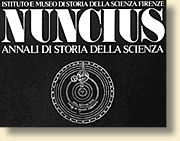
Institute and Museum of the History of Science, Florence, ITALY

2001/2
|
| The Galilean Lectures | |
|
J. RENN – M. VALLERIANI, Galileo and the challenge of the arsenal |
pag.481 |
|
P. ODIFREDDI, Galileo: infinitesimale, eppur infinito |
pag.505 |
|
Articoli |
|
|
P.
ALESSANDRO – P.D. NAPOLITANI, I primi contatti fra Maurolico e Clavio:
una nuova edizione della lettera di Francesco Maurolico a Francisco
Borgia |
pag.511 |
|
M.
O. HELBING, Una prima illustrazione a stampa del termometro |
pag.523 |
|
A.
LUALDI, La famiglia Selva, ottici del ‘700 veneziano |
pag. 531 |
|
C.
TRIARICO, About newly discovered pieces by Boscovich on optics and on
the finding of a vitrometrum |
pag. 547 |
| Per un Archivio della corrispondenza degli scienziati italiani | |
|
I.
CHINNICI – W. GRAMATOWSKI S. J., Le carte di Angelo Secchi S. J. (1818
– 1878) conservate presso la Pontificia Università Gregoriana.
Un inventario inedito rivisitato |
pag. 571 |
| Istituzioni e fonti | |
|
F.
BERETTA, Un nuovo documento sul processo di Galileo Galilei. La lettera
di Vincenzo Maculano del 22 aprile 1633 al cardinale Francesco Barberini |
pag.629 |
|
L.
GUERRINI, Nel dedalo del cielo. Gassendi e le macchie solari in un inedito
del 1633 |
pag.643 |
| Scientific Instrument Commission | |
The archives of scholars, collectors, and dealers: their place in the study of the history of scientific instruments – Papers from the XIXth Symposium of the Scientific Instrument Commission of the IUHPS. Division of the History of Science – Oxford, 2000.Introduction by Anthony Turner |
pag.675 |
M. MINIATI, About the Florentine Strozzi Manuscripts |
pag.681 |
W. J. H. ANREWES, The legacy of David Wheatland |
pag.687 |
W. F. J. MÖRZER BRUYNS, Alain Brieux, dealer and scholar in Paris: his archive on scientific instruments |
pag.703 |
S. ACKERMANN, Dormant treasures – The Zinner-archive at Frankfurt University |
pag.711 |
P. DE CLERCQ, The papers of the instrument dealer, collector and researcher Thomas Henry Court (1868 – 1951) |
pag.723 |
| K. VAN CLEEMPOEL, Henry Michel, a gentleman-scholar | pag.733 |
| B. STEPHENSON, The Derek price archive at the Adler Planetarium | pag.739 |
A. J. TURNER, The archive of Derek Price in the mèdiatèque specialise en histoire des sciences, cite des sciences et de l’industrie at La Villette in Paris |
pag.747 |
| I. KEILL, The papers of Maximilian Bobinger | pag.763 |
| Nova Media | |
A. TIOMNO TOLMASQUIM - A. MAGNO DA COSTA - L. ALVES LINO, Building the Brazilian bibliography of the history of science |
pag.767 |
F. PALLADINO – NICLA PALLADINO, Sulle raccolte museali italiane di modelli per le matematiche superiori – catalogo generale e sito web |
pag.781 |
| Discussioni critiche | |
A. ANGELINI, Magia e modernità. L’edizione delle opere magiche di Giordano Bruno |
pag.791 |
M. BERETTA, Reconstructing science: contributions to the enhancement of European scientific heritage |
pag.799 |
| Recensioni | pag.817 |
| Schede | pag.857 |
| The IMSS bookshelf | pag.885 |
| Indici (Anno XVI, 2001) | pag.893 |
| Back to contents |
2001/1
|
| Articoli | |
|
N.
FABBRI, Kepler: Il cosmo armonico e la musica |
pag.3 |
|
G.
NONNOI, La scienza e la filosofia galileiane nel New World di
John Wilkins |
pag.49 |
|
L.
ZUCCHI, Linneo e Parkinson: Il botanico e le scimmie nel Giardino dell’Eden
|
pag.85 |
|
L.
E. FUNARO, «Il criterio e la mano». Viaggi e donativi sovrani all’Imperiale
e Regio Museo fiorentino |
pag.153 |
|
G.
N. VLAHAKIS, Against French science: Alessandro Volta and Luigi Brugnatelli
in early nineteenth-century Greece |
pag.190 |
|
R.
PASSIONE, Mente e lavoro. Le prime ricerche in Italia fra laboratorio
e officina |
pag. 211 |
| Per un Archivio della Corrispondenza degli scienziati italiani | |
|
A.
MESCHIARI, Le carte del «Fondo Giovanni Battista Amici» e della «Raccolta
Amici Grossi» nella Biblioteca |
pag. 237 |
| Istituzioni e fonti | |
|
E.
ULIVI, Mariano Del M° Michele, un maestro d’abaco del XV secolo |
pag.301 |
|
C.
POGLIANO, Statements on Race dell’Unesco: cronaca di un lungo
travaglio (1949 – 1953) |
pag.347 |
| Recensioni | pag.401 |
| Schede | pag.441 |
| The IMSS bookshelf | pag.465 |
| Back to contents |
|
|
| [ Museum Home | Issues from 1996 | Nuncius | Italiano ] |
|
|
|
For further
information, please contact: |